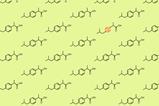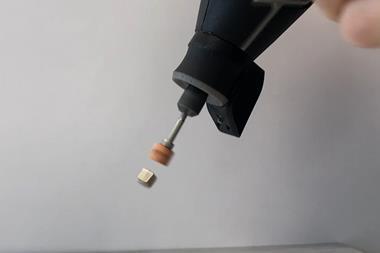
An eyebrow-raising claim to have produced the first room temperature and ambient pressure superconductor has sparked both excitement and scepticism in the scientific community. The race is now on to replicate these results with several groups already releasing preprints of their efforts just days after the claim came to widespread public notice.
The supposedly-superconducting material ‘LK-99’ is named after two of its discoverers Sukbae Lee and Ji-Hoon Kim, affiliated to the Quantum Energy Research Centre in Korea, and the year of its synthesis, 1999. Reports of LK-99’s room temperature and pressure superconductivity appeared in two preprints on the arXiv server in late July with a paper attributed to three authors, Lee, Kim and Young-Wan Kwon at Korea University in Seoul.
The material is a dark polycrystalline solid that can be synthesised from simple precursors in a laboratory in just a few days. Similar in structure to lead apatite, the material contains a 1:1 ratio of lanarkite, with the formula Pb2(SO4)O, and copper phosphide, with the formula Cu3P. These materials were heated under vacuum at 925°C for 10 hours, which led to some of the Pb2+ ions being replaced by Cu2+ ions to create a material with the structure Pb10-xCux(PO4)6O. The researchers believe this creates internal stress in the material as the Cu2+ ions are smaller. This in turn causes a reduction in the material’s volume and this extra space allows the formation of what is known as a superconducting quantum well. They propose that electron tunnelling between these quantum wells, is the reason behind the alleged superconductivity.
A video was released by the team that appeared to show the material levitating over a powerful magnet, demonstrating the Meissner effect. The Meissner effect, the ability to repel weak magnetic fields, is a phenomenon that is unique to superconducting materials.
The claims the researchers make are bold and currently unverified. The concluding line of one of the preprints reads: ‘We believe that our new development will be a brand-new historical event that opens a new era for humankind.’
Superconducting materials are already in everyday use, such as in MRI machines, but they require extremely low temperatures and high pressures to operate. Superconductivity claims at or close to room temperature have been made before but these materials were under phenomenally high pressures. A room-temperature-and-pressure superconductor would transform the field of materials science and have far-reaching impacts well beyond. If this material can superconduct in everyday conditions, it could revolutionise power grid energy efficiency and help speed up the development of quantum supercomputers.
Social science
The data used to support these claims, however, has raised eyebrows among many scientists. Materials scientists are now eagerly awaiting efforts to reproduce the work. Shortcomings in the quality of the preprint did not, however, stop a frenzy of social media activity.
Many groups are now attempting to recreate the material following the simple synthesis procedure. As the research has not been peer reviewed, efforts to replicate it are being made publicly available online in real-time, from government-funded laboratories to faceless social media accounts.
Researchers working out of the National Physical Laboratory of India were one of the first to replicate the synthesis of the compound and released a preprint stating that no bulk superconductivity was observed. And research from the School of Materials Science and Engineering in Beihang University has also failed to replicate the results, stating that the material was just a paramagnetic semiconductor.
The excitement generated by even the remote possibility of such a superconductor has led individuals, not just large scale labs, to attempt to synthesise the compound. Andrew McCarlip, a robotics engineer at Varda, has been documenting his attempts on X, formerly known as Twitter, and Twitch, a livestreaming website. Called ‘MeissnerOrBust’ he has been attempting to validate the research in real time.
An anonymous Twitter user claiming to be a molecular biologist working at the Institute of Gene Biology in Russia, has said that she has observed partial levitation, indicating either a strong diamagnet or a strong superconductor. Whilst this finding from @iris_IGB has received a lot of attention, she remains anonymous.
Michael Norman, a condensed matter physicist working in the materials science department of Argonne National Laboratory, US, told Science that his initial reaction to the reports were that the scientists ‘look like real amateurs’ given how they presented their findings. Speaking to Chemistry World he says that ‘there have obviously been some reports through the years of what are sometimes referred to as USOs, unidentified superconducting objects’. ‘When I look at the data it seems to me that there could be a possibility of copper filaments or inclusions being interspersed inside an insulating diamagnetic matrix, it could fool you into thinking you have superconductivity when you don’t,’ he adds.
Other materials scientists are excited by the apparent democratisation of the process to recreate LK-99. Taylor Sparks is an expert in materials science and engineering from the University of Utah, and he points out that previous peer-reviewed papers making superconductivity claims have been retracted from journals including Nature. He says posting on the preprint server arXiv has become the ‘de-facto way we share research, at least in the field of condensed matter physics’. As the synthesis is fairly simple he doesn’t see any reason why an amateur or hobbyist couldn’t replicate the findings. ‘Atoms are atoms, just because you’re in a national laboratory doesn’t mean that they’re going to behave differently for you. This isn’t an unobtainable compound for a hobbyist to make, humans have been mixing and firing things for thousands of years.’ He goes on to say that while the synthesis is simple, they may have trouble ‘quantifying the structure and determining it for sure, but that can be said for the original paper, which didn’t confirm the structure all that accurately.’
A team at Argonne National Laboratory are currently testing their own sample of the LK-99 compound and hope to report their results soon.

















No comments yet